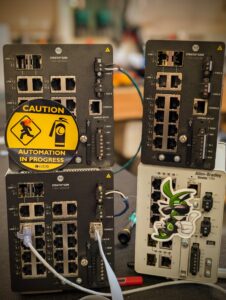Industrial Network Modernization:
Reliable, Scalable and High-Performance
Stop struggling with aging “flat” networks that can’t meet today’s demands for reliability, speed, and data integration.
Upgrading to a segmented, resilient network architecture can dramatically improve system uptime and performance. The network is the foundation upon which all production equipment and data systems rely, so a modern design must be robust enough to work under heavy use and be upgradable for future needs

Design
Industrial-focused, resilient network architecture designs to meet your current and future bandwidth, latency, and redundancy requirements.
From lightly managed local network segments, to inter-building fiber, to site-to-site secure VPN architectures, we have a solution for your plant.

Virtualization
Leverage a virtual infrastructure to reduce develop/deploy cycles, centralize management, and extend the life of legacy systems.
The virtual platform provides flexibility at the cost of vast array of performance-impacting design choices. Choosing the right host server, storage solution, backup/restore, redundancy, and licensing is the key to success.

Servers
Industrial Server and Client hardware requires extended life and support for 24/7/365 operations.
Lucid’s matches the hardware and operating systems to the industrial application. Systems are provided with controlled build documents, application software installed, tested, and life-cycle maintenance schedules
From Flat Networks to Segmented Architecture
Segmented network design fixes these issues by breaking the infrastructure into isolated zones or VLANs. By dividing an industrial network into smaller subnets or VLANs, you localize traffic and faults to specific segments.
For example, each production line, cell, or department can be on its own VLAN. If a problem occurs in one segment, it can be contained there without bringing down the whole plant
. This segmentation not only improves security (limiting unauthorized lateral movement) but also boosts reliability and simplifies troubleshooting – you can pinpoint and isolate issues much faster.
Reliability, Scalability, and Performance by Design
Reliability is paramount in industrial networks – downtime or hiccups can halt production and incur huge costs. Modern network design emphasizes reliability through both hardware and topology. Industrial-grade switches and routers offer ruggedness (for harsh environments) and features like dual power supplies and error-checking to keep running 24/7. On the design side, as mentioned, redundancy (spanning tree failovers, redundant uplinks, device-level ring networks, etc.) keeps communications flowing even if a component fails.
Moreover, all network changes or new deployments can be fully tested and documented before going live, to ensure they “work the first time” and meet any regulatory validation requirements.
Scalability is built into segmented networks. As production grows – with more sensors, controllers, HMI stations, or even entire new lines – a well-designed network can expand without a major overhaul. Managed switches make it easy to add ports or daisy-chain new network segments without disrupting the existing traffic. If bandwidth needs increase (for example, adding high-definition machine vision cameras or advanced robotics), the backbone can be scaled up – e.g. upgrading to fiber optic links or gigabit speeds to handle higher throughput.
Planning for scalability means choosing equipment that can accommodate future devices and higher traffic loads, ensuring that as your data needs grow, the network can grow with them. An optimized design avoids bottlenecks and has headroom, so adding a new data-intensive application won’t choke the system. The end goal is an architecture that adapts to evolving requirements with minimal friction.
Performance considerations in modern industrial networks go beyond raw speed – it’s about consistent, real-time responsiveness. Replacing outdated hubs or daisy-chained unmanaged switches with a proper switched Ethernet network dramatically reduces latency and jitter. Each switch port operating in full-duplex means no collisions and no needless retransmissions, so data gets from PLC to SCADA to Historian quickly and predictably.
Features like Quality of Service (QoS) can prioritize critical control traffic over less urgent data, ensuring control commands or safety signals are never delayed by bulk data transfers. The result is a high-performance network where operators and engineers see real-time data on their HMIs and historians without lag, and automation systems can exchange signals reliably in the timeframes the process requires.
Upgrading outdated network hardware and design enhances reliability, performance, and future readiness all at once. As one industry guide notes, improving network infrastructure is achieved by upgrading old hardware to boost performance and reliability, optimizing the design to eliminate bottlenecks, increasing bandwidth for higher data volumes, and implementing.
By investing in these improvements, plants ensure their network can handle current production needs and scale for tomorrow’s.
Proactive Network Monitoring and Resilience
Designing a resilient network is the first step; actively monitoring the network’s health is the next. Visibility into network performance is vital for preventing downtime. Modern industrial networks often include monitoring systems that track the status of switches, links, and traffic in real time.
By using SNMP-enabled managed switches or specialized industrial network monitoring tools, engineers can keep an eye on key indicators. Some critical metrics to watch include: port utilization (load), error counters, packet loss, and latency/jitter on the network.
Network monitoring tools today can even leverage analytics and AI to interpret patterns in the data. Faster access to detailed network health information means faster reaction and fix times.
Data Flow: Plant Floor to Enterprise
Today’s process engineers and operations managers increasingly rely on data-driven decision making – from real-time production dashboards to long-term analytics for process optimization. Key industrial systems like process historians, alarm and event databases, and electronic batch record systems all require timely, secure access to data from the shop floor. A modern network acts as the highway for this information, moving data from sensors and controllers at the plant floor up to the people and applications that need it in the enterprise.
With a robust network and proper data integration middleware, plant floor data becomes readily accessible to those who need it, without compromising the isolation and security of control systems.

Future Proofing Your Network
Future-Proofing with AI and Advanced Analytics
Upgrading industrial networks is also about preparing for the future of manufacturing. The AI and data analytics revolution in industry (often dubbed Industry 4.0 or smart manufacturing) is already underway, and it requires a solid data infrastructure.
By modernizing your network, you’re laying the groundwork for AI-driven operations like predictive maintenance, anomaly detection, and adaptive process control. These applications thrive on large volumes of high-quality data flowing from machines to analytics engines.
Predictive Maintenance
Implementing predictive maintenance on critical devices require continuous collection of dat and sending them to an AI model that can predict failures. The network needs to handle this constant stream of sensor data.
Bandwidth and Scalability
Ever-growing data streams including new IIoT sensors or high-frequency data logging for machine learning are components of modern infrastructure. Edge computing devices preprocess data, and they too need reliable network links to both the machines and the infrastructure
Enterprise Access Advantage
network modernization also future-proofs data access for the enterprise. As more business units want to leverage plant data (for quality analysis, supply chain optimization, etc.), having the infrastructure already in place to deliver that data securely is a competitive advantage.
Security
To truly future-proof, security can’t be ignored either. It’s worth noting that as networks become more connected (more conduits between OT and IT), ensuring a zero-trust security posture in the design is key. Segmentation and firewalling are part of that. It’s about protecting the integrity of your data and operations while enabling access.
